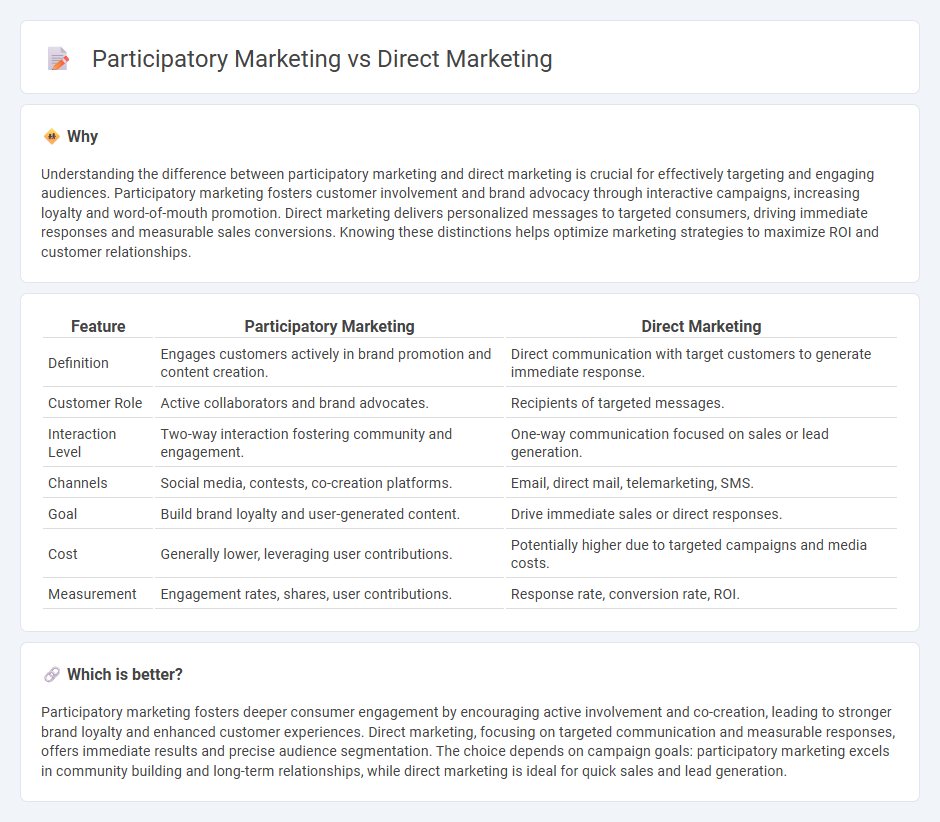
Participatory marketing engages customers as active contributors, fostering community interaction and brand loyalty through user-generated content and collaborative campaigns. Direct marketing targets specific audiences with personalized messages via channels like email, SMS, and direct mail, aiming for immediate response and measurable results. Explore more to understand which approach best amplifies your marketing strategy.
Why it is important
Understanding the difference between participatory marketing and direct marketing is crucial for effectively targeting and engaging audiences. Participatory marketing fosters customer involvement and brand advocacy through interactive campaigns, increasing loyalty and word-of-mouth promotion. Direct marketing delivers personalized messages to targeted consumers, driving immediate responses and measurable sales conversions. Knowing these distinctions helps optimize marketing strategies to maximize ROI and customer relationships.
Comparison Table
| Feature | Participatory Marketing | Direct Marketing |
|---|---|---|
| Definition | Engages customers actively in brand promotion and content creation. | Direct communication with target customers to generate immediate response. |
| Customer Role | Active collaborators and brand advocates. | Recipients of targeted messages. |
| Interaction Level | Two-way interaction fostering community and engagement. | One-way communication focused on sales or lead generation. |
| Channels | Social media, contests, co-creation platforms. | Email, direct mail, telemarketing, SMS. |
| Goal | Build brand loyalty and user-generated content. | Drive immediate sales or direct responses. |
| Cost | Generally lower, leveraging user contributions. | Potentially higher due to targeted campaigns and media costs. |
| Measurement | Engagement rates, shares, user contributions. | Response rate, conversion rate, ROI. |
Which is better?
Participatory marketing fosters deeper consumer engagement by encouraging active involvement and co-creation, leading to stronger brand loyalty and enhanced customer experiences. Direct marketing, focusing on targeted communication and measurable responses, offers immediate results and precise audience segmentation. The choice depends on campaign goals: participatory marketing excels in community building and long-term relationships, while direct marketing is ideal for quick sales and lead generation.
Connection
Participatory marketing and direct marketing both focus on engaging customers through personalized interactions that foster active involvement in brand messaging. Participatory marketing leverages consumer-generated content and feedback channels, while direct marketing targets individuals with tailored offers via email, SMS, or direct mail to drive immediate responses. The connection lies in their shared objective to create meaningful, two-way communication that enhances customer loyalty and conversion rates.
Key Terms
Direct Marketing:
Direct marketing leverages targeted communication channels such as email, telemarketing, and direct mail to deliver personalized messages that prompt immediate consumer response and measurable results. This approach uses data analytics to segment audiences and optimize campaign effectiveness, enhancing customer acquisition and retention rates. Explore more about how direct marketing strategies can elevate your business performance.
Personalization
Direct marketing leverages personalized messaging through targeted emails, direct mail, and telemarketing campaigns to reach specific customer segments based on demographics and past behaviors. Participatory marketing, meanwhile, emphasizes consumer engagement and co-creation, allowing customers to contribute ideas and feedback that tailor products and campaigns more dynamically. Explore how blending personalization in both strategies can enhance customer loyalty and drive higher conversion rates.
Call-to-Action (CTA)
Direct marketing emphasizes immediate Call-to-Action (CTA) prompts designed to generate quick responses through emails, phone calls, or direct mail, maximizing measurable conversions. Participatory marketing integrates CTA within interactive content, encouraging consumer engagement and co-creation that builds brand loyalty and sustained interaction. Explore deeper insights into crafting effective CTAs tailored for each marketing strategy to boost campaign performance.
Source and External Links
What Is Direct Marketing? Definition, Examples, and Guide - Shopify - Direct marketing delivers targeted advertising messages straight to individual customers using channels like email, social media, and direct mail, focusing on personalized communication to drive engagement and conversions.
What is Direct Marketing: Definition and Examples - Direct marketing is a campaign strategy aiming to initiate a personal relationship between the customer and the marketing organization, communicating directly without intermediaries and enabling direct customer responses.
Everything You Need to Know About Direct Marketing - Meltwater - Direct marketing is any marketing that relies on direct communication to individual consumers rather than mass media, emphasizing precision targeting, cost-effectiveness, and highly personalized offers.
 dowidth.com
dowidth.com